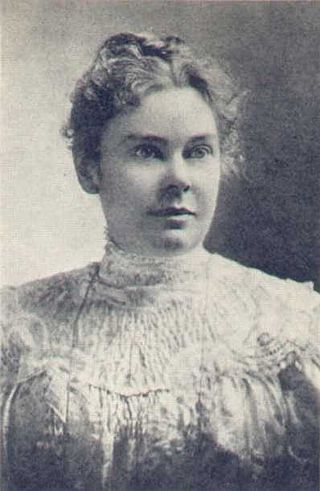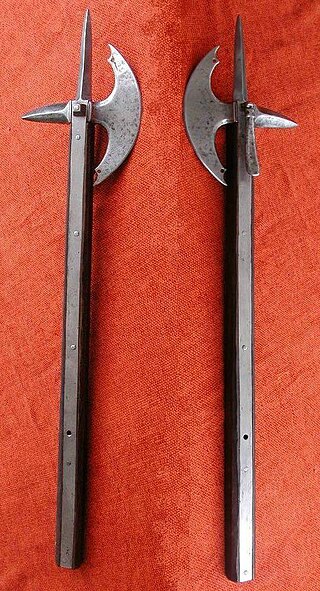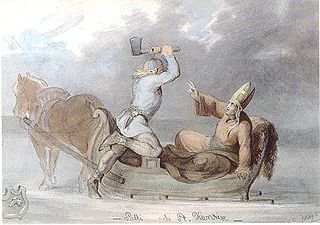
A broadaxe is a large (broad)-headed axe. There are two categories of cutting edge on broadaxes, both are used for shaping logs by hewing. On one type, one side is flat, and the other side beveled, a basilled edge, also called a side axe, single bevel, or chisle-edged axe. On the other type, both sides are beveled, sometimes called a double bevel axe, which produces a scalloped cut.

Lizzie Andrew Borden was an American woman who was tried and acquitted of the August 4, 1892 axe murders of her father and stepmother in Fall River, Massachusetts. No one else was charged in the murders, and, despite ostracism from other residents, Borden spent the remainder of her life in Fall River. She died of pneumonia at the age of 66, just days before the death of her older sister, Emma.

A tomahawk is a type of single-handed axe used by the many Indigenous peoples and nations of North America. It traditionally resembles a hatchet with a straight shaft. In pre-colonial times the head was made of stone, bone, or antler, and European settlers later introduced heads of iron and steel. The term came into the English language in the 17th century as an adaptation of the Powhatan word.

A hatchet is a single-handed striking tool with a sharp blade on one side used to cut and split wood, and a hammerhead on the other side. Hatchets may also be used for hewing when making flattened surfaces on logs; when the hatchet head is optimized for this purpose it is called a hewing hatchet.

A battle axe is an axe specifically designed for combat. Battle axes were specialized versions of utility axes. Many were suitable for use in one hand, while others were larger and were deployed two-handed.

Molly Hatchet is an American rock band formed by guitarist Dave Hlubek in Jacksonville, Florida, in 1971. They experienced popularity and commercial success during the late 1970s and early to mid-1980s amongst southern rock and hard rock communities and listeners. The band released six studio albums on Epic Records between 1978 and 1984, including the platinum-selling hit records Molly Hatchet (1978), Flirtin' with Disaster (1979), and Beatin' the Odds (1980). They also had charting singles on the US Billboard charts, including "Flirtin' with Disaster", "The Rambler", "Bloody Reunion" and "Satisfied Man". Molly Hatchet has released many more studio albums since their split with Epic Records in 1985, although none have been as successful as their early albums, nor have charted in the United States.

Ferry Farm, also known as the George Washington Boyhood Home Site or the Ferry Farm Site, is the farm and home where George Washington spent much of his childhood. The site is located in Stafford County, Virginia, along the northern bank of the Rappahannock River, across from the city of Fredericksburg. In July 2008, archaeologists announced that they had found remains of the boyhood home, which had suffered a fire during 1740, including artifacts such as pieces of a cream-colored tea set probably belonging to George's mother, Mary Ball Washington. In 2015, the George Washington Foundation began constructing a replica of Washington's boyhood home on the site of the original building. The replica house was completed in 2018 and is open to the public.

The Nzappa zap is a traditional weapon from the Congo similar to an axe or hatchet.
"Bury the hatchet" is an American English idiom meaning "to make peace". The phrase is an allusion to the figurative or literal practice of putting away weapons at the cessation of hostilities among or by Native Americans in the Eastern United States.

The Hatchet Inn is a historic pub in the English city of Bristol. It is a Grade II listed building. The name is thought to originate from the axes/hatchets that the local woodsmen used in Clifton Woods.
Hatchet House is the sub-label of independent record label Psychopathic Records, based in Royal Oak, Michigan in the United States, which was formed in 2007 by American hip hop group Insane Clown Posse.

An axe is an implement that has been used for millennia to shape, split, and cut wood, to harvest timber, as a weapon, and as a ceremonial or heraldic symbol. The axe has many forms and specialised uses but generally consists of an axe head with a handle, also called a haft or a helve.
Axes of Perun, also called "hatchet amulets", are archaeological artifacts worn as a pendant and shaped like a battle axe in honor of Perun, the supreme deity of Slavic religion. They are counterparts to Nordic Mjolnir amulets. They are mostly found in modern day Serbia, Russia, Ukraine, Belarus, Poland, Lithuania, Latvia and parts of Scandinavia. Connection with the Slavic pre-Christian god Perun was made by V. P. Darkevich, although some authors prefer the association with Norse material culture.

A battle-axe is a derogatory traditional stereotype describing a woman characterized as aggressive, overbearing and forceful. The term originated as a gender-independent descriptor in the early 20th century, but became primarily applied to women around the middle of the century.

The Mount William stone axe quarry is an Aboriginal Australian archaeological site in Central Victoria, Australia. It is located 9 kilometres (5.6 mi) northeast of Lancefield, off Powells Track, 10 kilometres (6.2 mi) north of Romsey and 78 kilometres (48 mi) from Melbourne. Known as Wil-im-ee moor-ring, meaning "axe place" in the Woiwurrung language, the greenstone quarry was an important source of raw material for the manufacture of greenstone ground-edge axes, which were traded over a wide area of south-east Australia.

An axe murder is a murder in which the victim was struck and killed by an axe or hatchet.

Stephen F. Brown was a Union Army officer in the American Civil War, and became famous for taking part in the Battle of Gettysburg armed only with a camp hatchet.

The tabar is a type of battle axe. The term tabar is used for axes originating from the Ottoman Empire, Persia, India and surrounding countries and cultures. As a loanword taken through Iranian Scythian, the word tabar is also used in most Slavic languages as the word for axe.
Sean Whalen is an American actor and writer. He is known for his work in numerous TV shows, including Shannon's Deal and Grace Under Fire, as well as movies, including The People Under the Stairs and Twister. He is also known for appearing as a hapless history buff in the first "Got Milk?" commercial, directed by Michael Bay, which aired in 1993.















